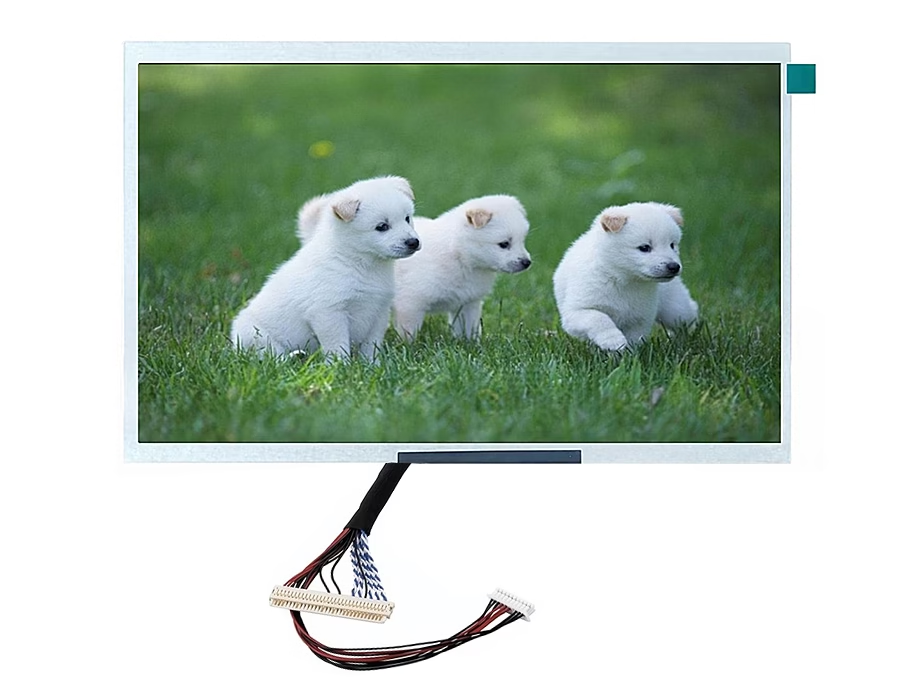
LVDS (Low-Voltage Differential Signaling) is a standard interface for TFT LCDs. It sends pixel data over low-voltage differential pairs, minimizing interference and power use. This yields a robust, low-noise video link. Modern displays often favor LVDS because it can send data at high rates (hundreds of Mbps) with very low EMI.
LVDS vs eDP vs HDMI
LVDS is an older display interface. Embedded DisplayPort (eDP) is a newer high-bandwidth standard. HDMI is a popular consumer AV interface. Each has trade-offs. See the table below for a summary comparison.
| Parameter | LVDS | eDP | HDMI (Consumer) |
|---|---|---|---|
| Data Rate | ≤7 Gbps total | ≤21 Gbps total | 10–48 Gbps |
| EMI/Noise | Low (diff pairs) | Low (diff pairs) | Moderate (needs shielding) |
| Typical Cost | Low (mature) | High (new tech) | Medium (mass-market) |
| Cable Length | ~1–5 m | <1 m (internal) | ~10 m (passive) |
| Complexity | Moderate (simple lanes) | High (packetized) | High (multimedia) |
Each interface excels in different scenarios. eDP is built for ultra-high resolutions and refresh rates (e.g., laptops and tablets). HDMI is ideal for TVs and monitors, as it carries both audio and video. LVDS, being an older standard, shines in stability and simplicity for medium-resolution panels.
When is LVDS the Right Choice?
Consider LVDS when you need a proven, cost-effective link for a TFT panel, especially in industrial or automotive applications. LVDS is common in devices like machine interfaces, medical displays, and dashboards, where reliability and low EMI are key. If your design doesn’t require 4K or ultra-high refresh rates, LVDS often meets the need without additional complexity.
By contrast, choose eDP for very high resolutions or modern laptops/tablets, and HDMI for consumer video outputs (e.g., TVs, projectors). LVDS remains the go-to solution in legacy and rugged systems. Although eDP has largely replaced LVDS in new laptops, many legacy panels and industrial screens continue to use LVDS.
How to Choose the Right LVDS Cable
Picking an LVDS cable involves matching your system’s specs and environment:
- Signal Integrity: LVDS requires a 100 Ω differential impedance. Choose cables with controlled impedance and consistent twist ratios to maintain signal clarity.
- Shielding/EMI: For noisy environments (industrial, vehicle), use shielded cables (foil/braid) to block electromagnetic interference. Well-shielded LVDS cables maintain clear video signals even in EMI-prone settings.
- Length vs Speed: Longer cables attenuate signals. A short LVDS cable (~1 m) easily handles multi-gigabit data; a 5 m cable may require thicker conductors or lower speed.
- Connector & Pinout: Ensure the cable matches your display’s interface (FFC/FPC type, pin count). Standard connectors include DF13, JAE, etc. A mismatched connector or pinout will not function properly.
- Durability: LVDS cables for automotive applications must withstand vibration and wide temperature swings; those for medical applications must meet stringent EMI specifications. Romtronic’s LVDS products are designed for such harsh conditions and are UL/CE certified.
Romtronic (our factory) supplies a complete line of LVDS cable assemblies built to these standards. We offer shielded twisted-pair ribbon cables (30-pin, 40-pin, etc.), fine-coax LVDS harnesses, and DF13/DF14 connector cables. All processes (twisting, crimping, testing) are done in-house, ensuring fast delivery (≈10–15 days) and high quality.
Romtronic’s LVDS Cable Products






As a manufacturer, Romtronic has extensive experience custom-building LVDS cables. Our product range includes standard and custom LVDS harnesses with various connectors and cable types (ultra-thin, high-density, etc.). With UL/CE certifications and OEM-level support, Romtronic’s LVDS cables can be tailored to your TFT display needs, saving design time and cost.
In summary, LVDS remains a solid choice for many TFT display projects. By understanding the interface and selecting a properly rated cable (considering length, shielding, and connector), you ensure reliable, high-quality video. At Romtronic, we take pride in delivering LVDS cables that meet these exact requirements.
.avif)
Sam Wu is the Marketing Manager at Romtronic, holding a degree in Mechatronics. With 12 years of experience in sales within the electronic wiring harness industry, he manages marketing efforts across Europe. An expert in cable assembly, wiring harnesses, and advanced connectivity solutions, Sam simplifies complex technologies, offering clear, actionable advice to help you confidently navigate your electrical projects.


